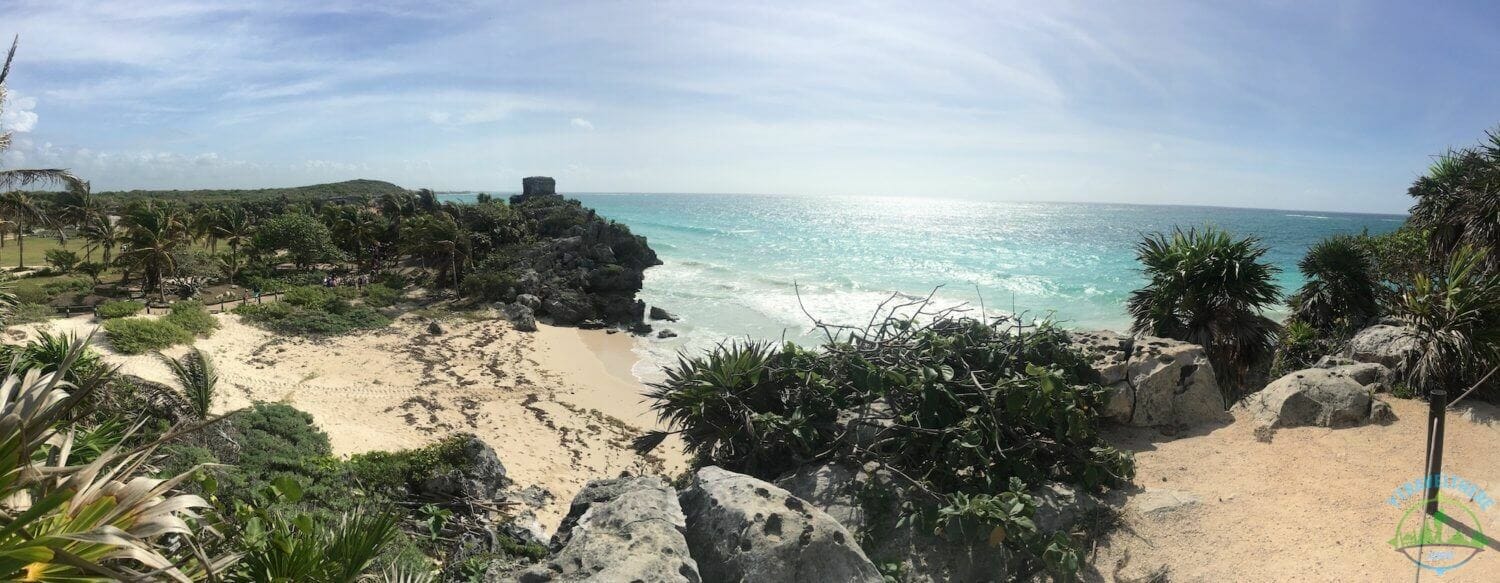Cancun has been the go to resort in the Yucatan for many years. Proximity to the airport has made it the number 1 choice for international visitors but towns further down the Riveria Maya are now stepping up to challenge its crown. Tulum may not be anywhere near the same scale as Cancun but there is more to this once sleepy trading village than the world famous ruins.
Getting To Tulum
Like most anywhere else in the world taxi’s are the most expensive option of getting around, particularly in the sprawingling Riveria Maya. Tulum lies 80 miles south of Cancun. It takes between 90 minutes and 2 hours depending on traffic. Thankfully there are plenty of options for getting around that are cheaper than taking a taxi.
ADO Busses
– Bus travel is a popular and cheap option for getting around compared to the expense of flying. ADO has an extensive network around the Yucatan. They run multiple daily schedules between Cancun, the airport and Playa Del Carmen every 30 minutes for around US$12. There is another ADO service that runs between Playa Del Carmen and Tulum. They will also stop at Xel Há and Xcaret eco parks on the way. There are also plenty of private transfer companies that offer airport shuttles and day trips around the Riveria.
Travel With The Locals
A cheaper option if you are staying in Playa Del Carmen is a collectivo. Used by workers up and down the Riveria Maya they depart as soon as they are full which never takes that long. The small white vans are a staple of the area. They depart from Calle 2 and Avenida 20 at the southern end of the resort and cost around $40MXN per trip. Journeys in the collectivo will take about 15 minutes less than an ADO bus but won’t be as comfortable. A great experience nonetheless and highly recommended.
The 3 Areas Of Tulum
Along with the town centre,Tulum Pueblo, which is set inland without beach access, Tulum has 2 other distinctive areas with some travel between each.
Day trippers will be most interested in the Tulum Ruinas area which is where you will find the world famous beachside ruins of Tulum. They are some distance from the main town and will require a taxi if you miss the dedicated stop. If you are getting a collectivo make sure to tell the driver that you want “ruinas” to avoid getting charged for a trip all the way into town.
Lastly, there is the hotel section more commonly referred to as Tulum Playa. The sprawling hotel zone stretches north of the Ruins towards Playa Del Carmen. This far out of town there is little in the way of anything outside the resorts but a taxi into Tulum shouldn’t cost too much if you want a walk around town. You don’t have to stay at one of these deluxe mega resorts though to enjoy the beach. There is a spectacular beach near the ruins if you want to add to your day after you visit the ruins.
Tulum’s Main Attractions
Ruinas de Tulum
Open Daily 8am-5pm; arrive before 10am to avoid the main crowds and tour groups
You can’t talk about Tulum and not mention the Ruins. They are a flat 1 mile walk from the highway. You can pay $20MXN (roughly US$2) for a land train but it’s an easy walk from the stop witch is flanked on either side by a small commercial zone of restaurants and shops. If you are arriving early there is a Starbucks for a caffeine kick.
Cichen Itza may be the most popular site in the Yucatan but few who see the spectacular beachfront ruins at Tulum would argue that it has one of the best views of all Mayan ruins. It was a small settlement of around 1000 people, far smaller than Chichen Itza and the long lost city of Tikal in neighbouring Guatemala. Surrounding the ruins, an 8 meter high wall has only has 5 openings, 2 to the north and south and 1 to the west. The ocean borders the east with towering cliffs making Tulum an important trading outpost at the height of the mayan empire. Clearly they knew the strategic importance of a site like Tulum.

The most striking image of Tulum is from behind El Castillo looking towards Temple Of The God Of Wind and its commanding cliff top perch.
There are 3 main structures within the walls, the main pyramid is called El Castillo (The Castle). It is easily the largest and most photogenic structure on site and attracts large groups of visitors throughout the day. While you can walk around it, you can’t get too close to it like all the main structures in Tulum. For a breathtaking entrance follow the main path from the ticket building all the way to the headland (follow the sign for the House Of The Cenote) without turning off.
Behind El Castillo, the small two storey Temple Of Frescoes is another popular stop for tours because of the quality of its carvings. It was used as an observatory for tracking the suns movements. Next to El Castillo is the 3rd main structure called Temple Of The Descending God. The structure is lit beautifully by the setting sun every day.
There are other structures within the walls, the Great Palace, House Of The Cenote and the much photographed if seldom known God Of Winds Temple. Guided tours are available for a small fee and won’t take longer than an hour. I would class the Ruins of Tulum as Mayan Ruins lite. The architecture is much the same as you will find in Chichen Itza without all the travelling and it is on a far smaller scale. If you are short on time they are ideal but it does feel like an on rails experience with all the main ruins cordoned off from the well prodded paths. Bring a swimsuit with you because one section of beach is open for sunbathing when the tide isn’t in. Alternatively you can visit a much larger neighbouring beach 10 minutes walk to the south after exiting the site.
If you are a fan of photography from above though please bear in mind that drone photography is banned in the national park. While photographs are allowed, video cameras require a permit costing $500MXN. Tripods are also on the forbidden list for a visit.
Visit A Cenote
Cenotes are a popular way to cool down in the heat of the afternoon. They are former caves where the roof has collapsed leaving a sinkhole and crystal clear freshwater pool. With the help of some stairs they are accessible for the public to swim in. They vary greatly and size and facilities and the best concentration of them is the area surrounding Tulum. Please bear in mind their fragile nature. Don’t apply any sun cream before entering to pool. Leave it at least half an hour after applying any before entering the water. El Gran Cenote is the most popular and probably the best option for first time cenote visits but it can become very crowded. Dos Ojos is probably the closest to the ruins but there is a 3km walk from the main entrance.

One of the the thousands of cenotes you can find in the Yucatan. This particular one has makeshift 3 meter and 10 meter diving platforms.
Visit an Eco Park
The Yucatan area is known for its eco friendly stance towards tourism activities. In between Tulum and Puerto Del Carmen lie 3 of the biggest eco parks in the Caribbean. Xel Há is 13km north of Tulum. It is built around a river inlet and lagoon. Your admission price includes all activities, food and drink so it’s not the cheapest of days out, especially if you are a family but if water based actives are your thing this will be a memorable day. X is Spanish is pronounced as ‘sh’ so Xel Há is pronounced as, “Shel Há”
Xcaret, (pronounced, “Shcaret”) meanwhile is owned and operated by the same group. While construction techniques may have been questionable, their eco friendly credentials were awarded gold status by Earth Check in 2014 through staff training, sustainability initiatives and purchasing decisions.

Xplor focuses more on adrenaline based activities. A separate ticket allows access to Xplor Fuego. Image ©Xcaret Enterprises
Xplor (pronounced as “Shplor”) is a later development from Xcaret Experiencias Group, opened in 2009 next door to Xcaret. The focus of Xplor is more adventure with zip lines, spelunking, rafting and amphibious vehicles all included in the entrance price. Xplor Fuego gives you nighttime access to the activities and special nighttime shows. Like all the eco parks here its a one price system. Once you’re in the gate everything is included. Cenotes will be much cheaper but for a day of adventure you won’t beat one of the eco parks, especially as a family which is the focus of Xenses Park a smaller park built around 15 fun activities to awaken mind and body to all the senses around us. Reports from previous visitors say that this parks is better to visit as a family unit or in small groups.
Be At One With Nature
For a day away from the crowds though, you won’t beat the immense Sian Ka’an Biosphere Reserve just beyond the city limits of Tulum. It was added to the UNESCO World Heritage List in 1987. It is the largest reserve in the Caribbean topping the scales at 528,148 hectares (5,280km²) with 140 miles of protected coastline and also encompasses part of the ocean and coral reef. It makes up 10% of the state of Quintana Roo, roughly twice the size of Rode Island in the USA. Hundreds of species of birds, mammals and fish call this place home. Visitors spend the day floating along the canals spotting local wildlife before exploring historic mayan ruins then cooling off snorkelling amongst 500 species of fish in the reef.
Relax And Unwind On A Palm Fringed Beach
The beach of Tulum really is a paradise. 10 minutes from the wall that marks the exit to the ruins (head left for the beach, right to go back to the entrance) a short stroll ends in a jaw on the floor moment as the white sand beach spreads out in front of you. Dotted with beach front clubs you can spend the day just relaxing on the beach and taking a cooling dip in the crystal clear turquoise blue waters of the Caribbean Sea without paying a penny. Federal law means all beaches in Mexico are public land. You cannot be stopped from using them but the beach clubs offer amenities such as restaurants and bars, sun beds and showers while some offer snorkelling trips out to the reef just off shore. An afternoon strolling the perfect white sand beach is probably the best value activity you can do in Tulum.
If you would like to compare the beach in Tulum to some other local offerings why not check out this related post from www.alltherooms.com. They compare some of the most common visited beaches with those less visited but still easy to get to. Which ever beach you visit on your trip to Mexico it is hard to feel disappointed.
Tulum – A Rough Diamond In The Caribbean
At first glance it is easy to overlook Tulum as a poor substitute to Cancun and Playa Del Carmen but its size is part of its charm. Its not at built up as its more well known neighbours but all the basics are there in the main town. A selection of budget friendly accommodation, restaurants and shops are all central. The main town may not be the most picturesque and access to the beach may be an issue for some who don’t stay in an all inclusive resort but it does have its own laid back charm. Stay further out and small commercial developments mean you wont have to travel too far for a drink or bite to eat while the mega resorts further out still are like mini towns in their own right. With superb local connections to neighbouring towns, and the international airport, Central America’s largest Biosphere Reserve on its doorstep and plenty of other things to do in easy reach, the time for Tulum to pull out of Cancun’s shadow may finally be upon it.
 Copyright secured by Digiprove © 2017
Copyright secured by Digiprove © 2017








